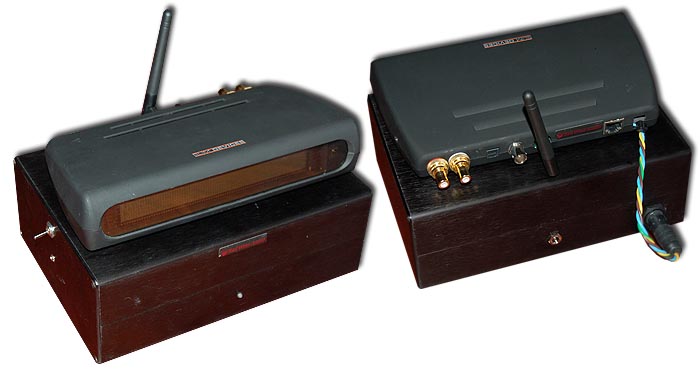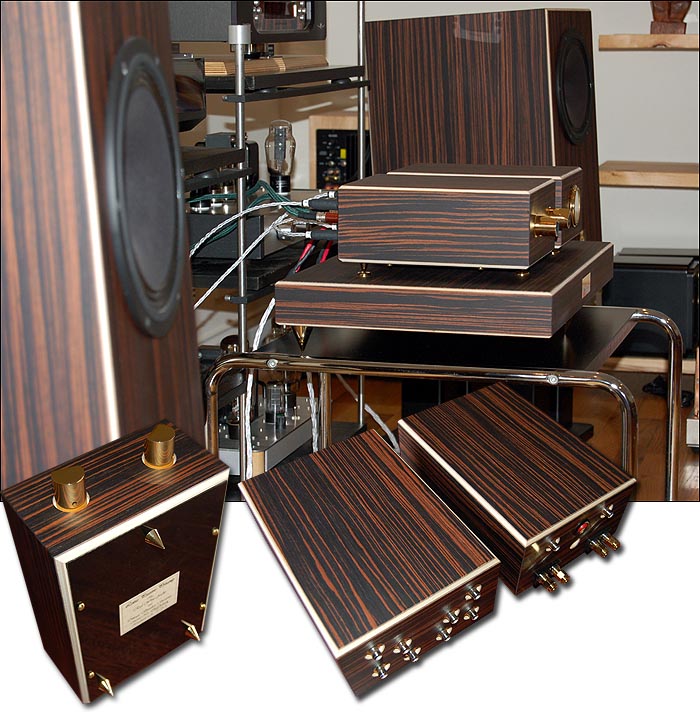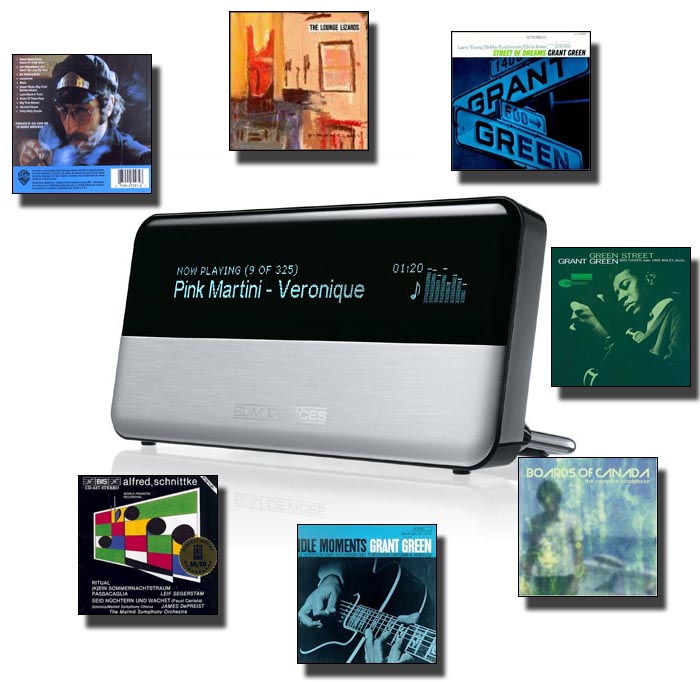|
|
|
|
|
This review page is supported in part by the sponsor whose ad is displayed above
|
|
 |
|
Red Wine Audio SqueezeBox 2 mod
The Red Wine Squeeze Box 2 is Vinnie's mod of the Slim Devices device of the same device - er, name. In brief, the SB2 is a wired and/or wireless music server that connects the music files on your computer's hard drive to your HiFi. I opted for the wireless route since I already have a wireless router and network installed. Vinnie's mods for the SB are extensive and include making it run off an SLA battery, replacing the stock DAC with an upgraded Burr Brown PCM1748KE, Auricaps and various other changes. Recharge times for the SB2 are "2 hours of use = approx. 1 hour to charge. 4 hours of use = approx. 2 hours to charge. 6 to 7 hours of use = approx. 3 to 4 hours to charge'. The SB2 also sports a full function remote and a "built-in 40-step volume control (performed digitally before the internal DAC)".
There's so much more to tell about the setup of a wireless music serving device, i.e. what software did I use to copy CDs to hard disk (iTunes 4.8.0.32); what formatting did I use (Apple Lossless with error correction on); what CD burner do I have (an internal piece of crap that came with my PC); what hard-drive type (external Western Digital 160GB); what interface for controlling the SB2 (Slim Server 6.2)... and that's just the surface details. I will say that I own a "quiet PC" which means I spent some time and money to get it nearly silent. The Antec Sonata case is fully lined with sound damping material and the fan is truly whisper quiet. Ambient room/house/outside noise is noisier than the 'puter. This was important since my PC lives in my listening room. I run Windows XP, Service Pack blah³. Connecting up the SB2 and getting it to see my iTunes library was very easy. The SB2 auto-detects your network and you just enter some details, like your wireless network encryption key --which you should use so you're not that kind of neighborhood hot spot -- and off you go.
Vinnie recently announced the availability of his SqueezeBox 3 mod. Sonically identical according to Vinnie, the SB3 sports some greatly enhanced visuals.
|
|
 |
|
 |
|
Audiopath silver cables from Hudson Audio
To complete the RMAF setup and to set right some serious cable oversight, we have the Audiopath silver cables connecting up the works. From the Hudson Audio website, the Audiopath cables are "pure silver cable made from a combination of eight strands of 99.9999% silver. Wire size is 13AWG and is braided for shielding. Termination is done by hand with a choice of banana or Cardas silver spade lugs for the speaker cable and RCA male plugs for the interconnects. Cardas silver solder is used for all terminations."
The Audiopath silver cables are very pliable and easy to work with. I asked Tom Hills, the personable proprietor of Hudson Audio and the man behind Audiopath cables, for banana termination on the speaker cable. Both Cardas RCAs and Vampire bananas are excellent connectors, providing tightly gripping joins. The appearance of the Audiopaths is right up there with the other components and I find the less-is-more approach to cables a sensible and welcome style. While I dig watching the dude in Gatorland wrestle the crocs in the pond, I'd rather not risk whip-scars when routing my cable.
|
|
| I asked Tom for a little background on Audiopath: "I started in the mid seventies building communication cables used in the Datacom industry. For a long time, I did part-time cable repair for both data and audio at night. In 1999, I was unhappy with the current phono cables that were available. Most companies were producing interconnects and using them for phono. There were two problems that needed to be addressed. One was signal loss due to the low voltage levels coming from the cartridges. The second was shielding and lowering the noise floor. I felt that silver done right would partly solve the signal loss problem. And the type of shielding could solve noise problems. Also low loss RCAs |
|
that sounded good would help pass all or most of the signal to the phono stage. That's when I started producing serious interconnects. After that, I worked on speaker cables, power cords and power strips."
"All of the Audiopath cables are made by hand. I also make an OEM line for Omega Loudspeakers called OmegAudio cables. These are all copper. I have known Louis since 2001. I always liked the single-driver speakers. I needed something for my low-powered SET amps. I tried the Fostex designs that Louis was making at the time and was very happy with the sound. At that time, I signed on to become a dealer."
|
|
 |
|
Free Mason synergy
There's a silent player in this system story and one worthy of a brief aside. According to Vinnie, "Dan Mason is responsible for turning me on to high-efficiency speakers. He suggested that I contact Louis of Omega Loudspeakers to listen to my ClariT amp with his various Omega models. I took Dan's advice and after Louis and I hooked up, we both realized that there was something big happening (Dan called it a "paradigm shift towards the use of battery-powered, low-power amplifiers with higher sensitivity speakers"). Louis never heard a solid-state amp that sounded like the ClariT (he was a die-hard tube user), and I was amazed by how well the ClariT drove the high-efficiency Omegas (which sounded and were built in a league of their own, especially in their price range)."
Dan Mason, aka DMason on Audio Circle, also turned on Vinnie to the Visaton B200 drivers. The Gravity Well of A DarkStar thread on AC has some twenty-odd thousand views and nearly fifty pages of posts. In the beginning was DarkStar: "In the interest of sharing an astounding synergy in sound, I have encouraged Richard, mxgsr and Gmood1 to get going on their own open baffle experiments combining their ClariT amps with the power source of Hawking's DarkStar, the Visaton B200 wide-range driver." Beyond his flair for some fanciful expletives, Dan's a matchmaker of people and gear as this review bears witness. The Gravity Well thread led to Vinnie trying the B200s in an open baffle and eventually to Louis' A8s. And the rest, as they say, is this-story. Keep an eye out for an Omega/Darkstar collaboration in the near future.
|
|
 |
|
If she rides as good as she looks...
... she'd be a keeper. Grant Green. Green Street [Blue Note 7243 5 40032 2 6], Street of Dreams [blue note 7243 8 21290 2 8] and Idle Moments [blue note 7243 4 99003 2 5]. I burned a bunch of my GG CDs and let 'em rip in order the old- fashioned way. This is not particularly taxing music but you want to get into it. You want an honest, balanced tuneful event. Based on my prior Red Wine experience, I have to admit I was a bit doubtful of tone. Maybe I've mellowed some but I was not left wanting. No dryness, nothing brittle or arid. Vinnie suggests the Auricaps in the Lotus amp are largely responsible for the improvement in sound quality over the previously reviewed unit. I smell synergy too. Perhaps the last bit of ultimate tone, cymbal sparkle and bass body was missing but that's on a Sherlock Audio level. On a listener level, this was tuneful. And all those positive traits that traveled with the Custom Clari-T are on display in the Lotus as well; super speed, excellent pace and deaf-defying quiet operation.
No Pain For Cakes [island7 90592-2] is another Lounge Lizards soundtrack for the film that is John Lurie. Theatrical and jivey, the Lizards juke their way through tango-inspired romps, background music for a very cool day in the life. These are thick, layered fast-paced tunes and the speed of the Lotus amp is all over this recording like a good date. And the Omegas are up to the task as well. No lagging, no thinness, just pure energized stomp. Marc Ribot is an interesting guitarist and on "The Magic of Palermo", he's tearing it up behind a wall of sax, trombone, piano, bass and drums. The Lotus/A8s let you follow him note for note. I had the pleasure of seeing the boys back in the day at the Bottom Line and John Lurie's distinctive voice is convincingly conveyed on his talkier tracks. By the way, that's one of John's paintings dubbed "Uncle Wiggiley As the Devil" gracing the cover - multi-talented like today's pairing. Bass performance is also worthy of mention and I did not find myself wanting to sub. I should mention I am no bass freak so take that for what it's worth. But once again this was tuneful and solid. The A8s also pull that monitor disappearing act and throw out a convincing and wide sound.
And if I told you I dug Leon Redbone, would you still respect me in the morning? In deference to what I consider a huge marketing blunder, I have reproduced the back cover photo rather than the cartoon frog that graces the true cover for On the Track [wb 2888 2]. I guess Warner Brothers had the cartoon-making talent of Chuck Jones on payroll anyway and their PR people just couldn't help but think Leon sounded like one of their comic strip frogs. Silly Wabbits. Leon Redbone, if you'd care to listen, can play some mean-ass laid-back guitar. Finger-style from the roots of the blues, he's a one-man band frustratingly placed behind a band. In this, his debut, his fretwork is more upfront and spotlighted than in later recordings. Leon's deep baritone and guitar, accompanying tuba, Hawaiian guitar and castanets... they all click and clack convincingly and nobody picks "Polly Wolly Doodle" with such aplomb. One always wonders if Redbone's Crosby-esque (as in Bing) crooning isn't enhanced by his tongue being firmly planted in his cheek.
|
|
 |
|
I went through a host of music played through the SB2. Some Feist from Let it Bleed, A Girl Named Eddy, Morton Feldman from Pieces for more than two hands and Nick Cave from that great Rarities triple disk treat. And I was treated each time to a musical picture that was at once convincing and easy to get along with.
Since I was enjoying myself, relaxing, the obvious next step was to try and break the peace. Find the soft white underbelly to reveal a gaping audiophile weakness for all to see. And what better companion into this grizzly deed than Alfred Schnittke's Faust Cantata [BIS CD 437]. Schnittke's "contemporary reality will make it necessary to experience all the music one has heard since childhood, including rock and jazz and classical and all other forms, [as] a synthesis." Schnittke has commingled these varied musical forms into a wild sensory stew in the retelling of the demise of Dr. Faustus at the hands of the devil. From a 1992 review in the New Republic by Alex Ross, "in the BIS recording, Inger Blom presides over a hectic cabaret orchestra like some Ethel Merman of the apocalypse." Did Ethel of the apocalypse sing our systems' undoing as well? Well, as it turns out, the SB2 is somewhat limited, dynamically. This never really glares and only shows itself on challenging material like Ethel's apocalyptic reverie. I did sub the Audio Aero Capitole at times and there's just more drive and dynamic variation with the admittedly pricey player within this modestly priced rig. One could call the SB2 polite by comparison.
Did I mention this rig can play loud? As loud as I care to rarely listen. Even Mephisto was well served at maniacal levels. And things gel at lower levels, too. The Lotus/A8 really does deliver the combo meal. They complement one another. They're a couple. The Visaton B200s are super fast, detailed and have impressive frequency extension in the Omega Aperiodic cabinet. I would describe their overall tonal balance as fat (or phat if you prefer). The Lotus amp is dead silent, super fast and really a master at micro-detail retrieval. And as previously noted, it can sound a bit thin. While an oversimplification, therein lays the love. Just like Jack Sprat and his wife who was phat, tonal opposites attract and serve up a well-balanced meal. DarkStar as sonic sommelier has pointed the way to this Tripath/Visaton B200 pairing. I say "Bon Appetite".
|
|
|
Would I prefer a tubed amp? Or perhaps a tubed preamp? Well and in brief, the Déjà Vu preamp introduced too much noise and a midrange emphasis that was not a welcome addition. Of the tube amps I have on hand, I found the winningest combination to be the Fi 45 with the Lotus passive. The 45 delivers very nearly as much detail as the digital amp while extending tonality and spaciality to the nether reaches of enjoyment. It is also worth a mention that the new Boards of Canada LP, the campfire headphase [warp] -- and part of Ken Micallef's 2005 Best of -- is a wonderful album. Discreet, aged, familiar yet just odd enough to keep you intrigued. The headphase through the Fi 45/Omega was ethereal. The Fi X is also a fine match with the Lotus passive and A8s although a tad noisy. And the budget combo worthy of careful consideration is the EL84-based Minute amp. While not nearly as concerned with the minutiae of the musical event, it is nonetheless musical and tuneful. Big bottom boogie.
|
|
 |
|
| Substituting the Audiopath cables with some in-house copper proved to take away some clarity and speed in |
|
exchange for body and a softer tone. All things considered, the Audiopath Silver cables are very well priced for solid performing, hand-made silver cables. Tom Hills also offers an OEM line of OmegAudio cables which use the same OFC stranded copper that's in the A8s and may be the ticket for those looking for a slightly less hot system sound. They may also be a good solution to the budget-restrained, costing $149 per 1-meter pair for the interconnects and $189/pair for 8' speaker cable.
The Wizard of Audio Gone
Comparative component meddling is the playground of the devil. Temptation with a capital T & A. "I like my rig but do you think that new ABC amp is better than my XYZ?" The endless upgrade itch you never can scratch. The lifeblood of AudiogoN. What if I were to tell you there's a land of milk & honey and its name is musically balanced? Have I heard deeper bass (yes) or airier highs (yes) or more convincing tone (yes)? But more importantly, have I heard all this better deeper air in one system coupled with the excellent detail retrieval, super-fast transient response and zero system noise of the Lotus/Lotus/Omega/Audiopath? My answer is yes again - but never for this kind of cool lean cash. Of course you can harvest some of these components and piece together something more...
Aha! Gotcha. Musically balanced is cool. It lets you listen to your tunes and relax. I'm not suggesting this is an easy road to travel. It's fraught with many an obstacle, namely audiophiles and reviewers touting the latest and greatest shiny new gear that excels at some particular sonic trivia. Like a bad witch, we hurls fire balls aimed at igniting the passion that is the straw called audiophilia. Louis and Vinnie have tried their best to get you some help. Short of painting the way, they've gone so far as to make these components look like they really go together. Because they do. They're even willing to give you back a hundred bucks reward for following this musically balanced road. Then again, you won't have heard the scores of components one could use to build a system of comparable cost. But I have news for you: no one has. There are just too many options. Trial and error in the $5K system arena can be a lifetime obsession. I don't know about you but I've got too much music to enjoy. |
|
|
 |
|
|
Red Wine Audio responds:
Hi Michael,
On behalf of all of us, I want to thank 6moons and you personally for all your time and effort in writing this complete system review. Since you couldn’t make it to RMAF, we all thought it would be fun to bring all the gear from our room in Denver to you. We’re glad that everything gelled so nicely together. Your review was a pleasure to read and you touched on so many important topics, especially system synergy. As always, the photography and layout is total eye candy.
This year has been a lot of fun for all of us and we have a bunch of new ideas planned for 2006. We will continue to provide unique, high-performance home audio products to our customers at an affordable price and we thank them for all their support!
Sincerely,
Vinnie Rossi
Red Wine Audio, Inc. |
|
|
|
 |
|
|
|
|
|
|
|
 |
|
 |
|
|
|
|
|
|
|
|
|
|
|
|